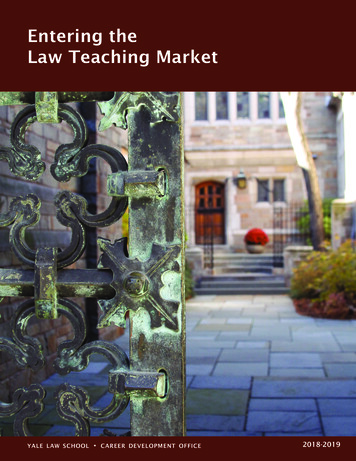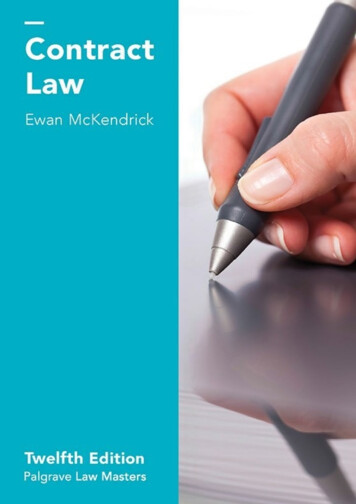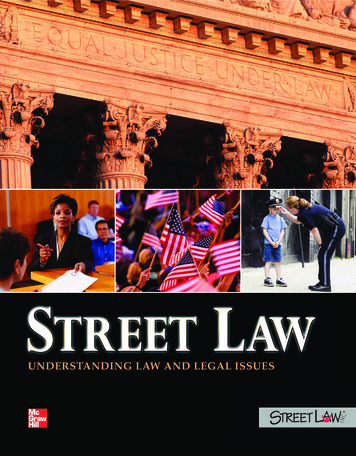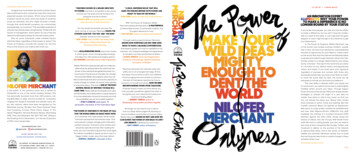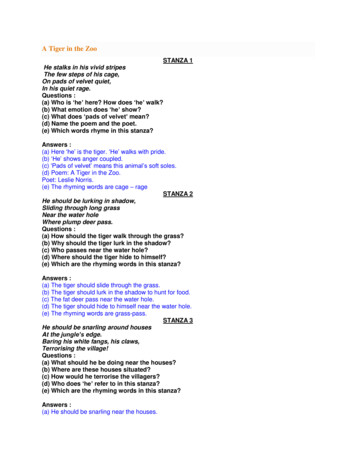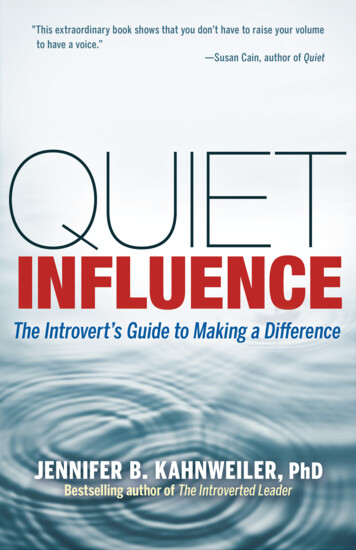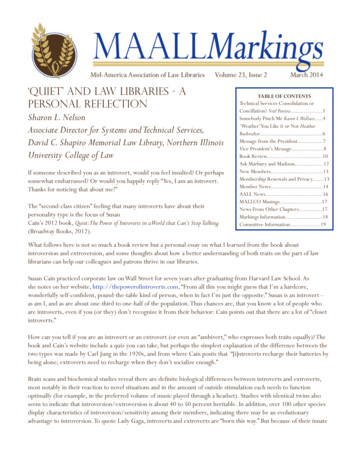
Transcription
‘quiet’ and law libraries - apersonal reflectionSharon L. NelsonAssociate Director for Systems and Technical Services,David C. Shapiro Memorial Law Library, Northern IllinoisUniversity College of LawIf someone described you as an introvert, would you feel insulted? Or perhapssomewhat embarrassed? Or would you happily reply “Yes, I am an introvert.Thanks for noticing that about me!”The “second-class citizen” feeling that many introverts have about theirpersonality type is the focus of SusanCain’s 2012 book, Quiet:The Power of Introverts in aWorld that Can’t Stop Talking(Broadway Books, 2012).TABLE OF CONTENTSTechnical Services Consolidation orConcillation? Neil Pereira.3Somebody Pinch Me Karen L.Wallace.4‘Weather’You Like it or Not HeatherBuckwalter.6Message from the President.7Vice President’s Message.8Book Review.10Ask Marbury and Madison.12New Members.13Membership Renewals and Privacy.13Member News.14AALL News.16MALLCO Musings.17News From Other Chapters.17Markings Information.18Committee Information.19What follows here is not so much a book review but a personal essay on what I learned from the book aboutintroversion and extroversion, and some thoughts about how a better understanding of both traits on the part of lawlibrarians can help our colleagues and patrons thrive in our libraries.Susan Cain practiced corporate law on Wall Street for seven years after graduating from Harvard Law School. Asshe notes on her website, http://thepowerofintroverts.com, “From all this you might guess that I’m a hardcore,wonderfully self-confident, pound-the-table kind of person, when in fact I’m just the opposite.” Susan is an introvert –as am I, and as are about one-third to one-half of the population. Thus chances are, that you know a lot of people whoare introverts, even if you (or they) don’t recognize it from their behavior: Cain points out that there are a lot of “closetintroverts.”How can you tell if you are an introvert or an extrovert (or even an “ambivert,” who expresses both traits equally)? Thebook and Cain’s website include a quiz you can take, but perhaps the simplest explanation of the difference between thetwo types was made by Carl Jung in the 1920s, and from where Cain posits that “[i]ntroverts recharge their batteries bybeing alone; extroverts need to recharge when they don’t socialize enough.”Brain scans and biochemical studies reveal there are definite biological differences between introverts and extroverts,most notably in their reaction to novel situations and in the amount of outside stimulation each needs to functionoptimally (for example, in the preferred volume of music played through a headset). Studies with identical twins alsoseem to indicate that introversion/extroversion is about 40 to 50 percent heritable. In addition, over 100 other speciesdisplay characteristics of introversion/sensitivity among their members, indicating there may be an evolutionaryadvantage to introversion. To quote Lady Gaga, introverts and extroverts are “born this way.” But because of their innate
sensitivity to stimulation and their innate caution when faced with new experiences, most introverts tend to have aquieter, more low-key style than extroverts, with a different way of approaching the world and other people. Notbetter, not worse --- just different.Yet as widespread as introversion is in the general population, it has somehow been given a bad name in 21st centuryAmerica. Cain attributes this to the “Extrovert Ideal,” a societal belief that arose in the early 20th century that “the idealself is gregarious, alpha, and comfortable in the spotlight” – especially at work and in school.Yet this group-orientedideal, prevalent as it is, may not always be the most optimal way to get things done. Among some of her findings that Ifound especially intriguing are the following: While seventy percent of employees now work in open-plan offices designed to facilitate working in teams,studies reveal that such offices reduce productivity, impair memory, and increase health problems. A study ofcomputer programmers revealed that the best employees worked for companies that gave employees the mostprivacy, personal space and freedom from interruptions. College students who usually study alone learn more than those who work in groups. In-person group brainstorming doesn’t generate as many good ideas as individuals working alone, andperformance decreases as the group size increases – though the opposite is true of online brainstorming,which improves with a larger group. Extroverts are usually better managers for passive employees. However, introverts are usually better managersfor proactive, initiative-taking employees that are so valued by modern organizations.What does all this have to do with law libraries? If you think about it, the strengths of both personality types areessential to the practice of law: the careful, analytical, and creative abilities that are the hallmarks of introverts, as wellas the people skills, quick decision-making, and ability to deal with conflict that are the hallmarks of extroverts. Beingaware of the introvert-extrovert spectrum can help us make accommodations for both types in our libraries. We canprovide better physical spaces for our patrons and staff, better understand from where our patrons are coming, developteaching and service delivery models that reach both introverts and extroverts , and (if we’re introverts ourselves) learnwhat we need to do to move through life with greater grace, creativity, and productivity.Most libraries have abandoned an atmosphere of pin-drop silence for a mix of group/noisy and individual/quiet areasin their public spaces. This is ideal for both introverts and extroverts. The best work settings allow people to freelyjoin whatever groups they need, while providing an option to retreat into a privatearea where they can focus or be alone. Unfortunately our staff work areas may notprovide the same mix of group and private spaces. Since remodeling your workspacemay not be possible, staff who work in open-plan offices could be permitted touse more private areas of the building when working on tasks demanding quietand concentration – perhaps an empty office, unused cubicle, or a corner ofthe public space less frequented by patrons. Conversely, if staff members areisolated in separate offices or scattered throughout the building, setting up a smallgathering place with a table and some chairs can foster informal conversation andcollaboration, and provide a haven for extroverts.Reading Cain’s book will likely provide insights into why your introverted patronsand colleagues behave as they do. Perhaps a colleague says little in a staff meeting,but later sends out an email on the topic that sways everyone to that point of view.Perhaps an attorney at your firm delivers brilliant presentations on complex aspectsMAALL MarkingsVolume 23, Issue 2 Page 2
of tax law, but freezes if required to speak extemporaneously (a real-life story featured in the book). Cain also providesan entire chapter on communicating across types to make it easier for introverts to talk to, and understand extroverts,and vice versa.If you teach, how can you best reach both introverted and extroverted students? In general, Cain notes, extroverts likemovement, stimulation and collaborative work, while introverts prefer lectures, independent projects, and downtime,and to work in smaller groups than extroverts. By providing a mix of types of activities, you are better able to reach allstudents. While in this section of the book Cain is specifically talking about teaching younger children, brain scans haveshown that some aspects ofsensitivity/introversion persist throughout a lifetime. Therefore offering introverted and extroverted law students(or even practicing attorneys) activities that fall within their natural comfort levels may help them learn what you areteaching them more easily.So you’ve decided to examine the mix of quiet and gregarious spaces in your library, want to understand some of yourpatrons a bit better, and are maybe thinking about changing your teaching to accommodate both personality types. Ifyou’re an introvert, how do you do all that (and everything else that’s on your plate) without crashing and burning?The key is to remember that introverts are hard-wired to function best at lower levels of novelty and stimulation. Thatdoesn’t mean introverts can’t handle high-stress, high-demand situations. Cain provides several examples of individualswho do so, and argues convincingly that for introverts, stretching beyond their comfort levels is usually good for them.Even the strong biological and genetic basis for introversion and extroversion only accounts for half of our behavior,and that gives each of us a lot of leeway. But Cain cautions that like rubber bands we can only stretch so far beyond ourinnate type, and there is something to be said for trying to set up your life so you are able to spend most of your timewithin the “sweet spot” of novelty and stimulation for your type.One strategy for staying in the sweet spot for your type is to create “restorative niches” in your life, whichCain describes as “the place you go when you want to return to your true self.” Niches can be physicalplaces, like a peaceful park for an introvert, or a crowded restaurant for an extrovert. Niches can alsobe temporal, like taking a long break in the restroom in-between meetings. (Cain notes that hiding outin restrooms is a favorite escape hatch for introverts.) Many introverts have created such breaks in theirday instinctively, but perhaps felt bad or weak about doing so instead of seeing downtime as essential totheir physiology. Similarly, extroverts may berate themselves for not being disciplined enough to spendtwo hours poring over a spreadsheet, when they truly need to spend ten minutes chatting with a colleague – or at leastturning up the music on their headset while they crunch numbers.I have only scratched the surface of the many interesting aspects of introversion and extroversion that Cain covers inher book. I hope this article has intrigued you enough to seek it out and read it for yourself.You may discover in it afascinating key to the friends, relations, patrons and colleagues in your life – and perhaps even to yourself.Technical Services Consolidation orConciliation?Cornelius PereiraAcquisitions/Catalog Librarian, Southern Illinois UniversityHow does Technical Services operate in your library? How many people do you employ? Is it small, medium-sized,or large? What relationship does Technical Services have with the other departments in your library? Is it reflectiveMAALL MarkingsVolume 23, Issue 2 Page 3
of a conglomeration of warring tribes or does everyone co-exist peacefully? Oh, really? Peace? Importantly, whatis comprised of Technical Services? How do budget constraints affect this department? Are we seeing more of aconsolidation between other departments in the library, and if so, how has that impacted Technical Services? Has thisdepartment vanished in your library, albeit to re-surface under some weird acronym, to please Mr. Administrator?What about the staffing of this department? How many people are there, and what duties do they have? Normalquestions all, for those of us coping with these demands. It will be interesting to see how other libraries within thisgroup deal with the manifold issues arising out of Technical Services in response to these and other questions. So I amsoliciting your responses, here, in order to get an idea as to how different or similar we are.At the Southern Illinois University School of Law Library—deep breath to recover from that title—Technical Servicesconsists of Acquisitions, Cataloging, Serials, Government Documents, and Binding and Preservation. A case couldcertainly be made for binding some people here, but preservation would be out of the question! Acquisitions handles,ahem, Acquisitions and Government Documents, while Cataloging has Binding and Preservation in addition to itseponymous duties. Serials is as Serials always has been, a royal pain in the—oh, well, look at the time! Claimingtitles, within Serials, can be problematic if it is not attended to on a definite schedule, but then so can a host of othersituations within life’s myriad duties in this department. Does anyone know of a school that has enough money? Nevermind Harvard’s multi-billion dollar endowment. Here the only thing endowed is the trouble that comes with trying tostay solvent and relevant.We have three staff members (herein we intone the dies irae), led by an industrious (some would say, hidebound), andcogent man (most would say obnoxious) with a mellifluous temperament—all would say cantankerous! We undertakeall the duties that come with running Technical Services. So there is some consolidation here, where we could have alarger staff dealing with individual areas. We have lost some staff recently.Apparently we’ve given up the search, and there could well lead to more consolidation. Severe budget constraints—we do live in Illinois, people!--have forced cuts in our materials, leading to lesser items to be checked in or filed andso on, while we are only a 12.2% depository library, as far as Government Documents is concerned. That, in and ofitself, should tell you that there is not too much material, especially from the federal domain, since most titles aregoing electronic—if ever there was something to write about, here is an item—while others have just gone! The Statemore than makes up for the lack of federal titles, but given the State’s penchant towards attending to appeals fromgubernatorial incarcerations and pension reform, things can be rather bleak, at times, on that front, as well. So weexist, and in the interests of all concerned, I must say, peacefully! Now how about you?Somebody Pinch Me Karen L.WallaceCirculation/Reference Librarian and Professor of Librarianship,Drake University LawLibrary“Somebody pinch me,‘cause I can’t believe I’m here.This is something that I’ve dreamed of all my life. . . Ready or not, Omaha,Nebraska,‘cause here we come.” – Bowling for Soup’s song “(Ready or Not) Omaha Nebraska”I grew up in Omaha, so the 2013 MAALL meeting was a homecoming for me. For a grown woman, I had a surprisinglygood time interacting with the Durham Museum’s Omaha floor map, stepping on my old schools and houses—andwatching the other folks with Omaha connections do the same. At the risk of being too schmaltzy, MAALL always feelsa bit like a homecoming. It’s wonderful to connect face-to-face with so many colleagues from libraries throughout theregion. The informal conversations are always one of the most rewarding parts of the conference for me, and this yearMAALL MarkingsVolume 23, Issue 2 Page 4
was no exception.I saw Jeri Kay Hopkins at the registration table and learned she had nearly been unable to attend. The Eighth CircuitCourt of Appeals had recently declared the court librarians essential employees; had the federal government not beenfunded and re-opened the night before the meeting started, we all would have missed out on Jeri Kay’s presence. Thequestion of what is and is not essential has become especially pertinent to us all in these challenging fiscal times. For avariety of reasons both NIU and KU have some significant staff shortages now. I chatted with Therese Clarke Arado atNIU about how they have been identifying tasks they no longer need to do, such as questioning whether statistics theyhave historically gathered ever are used to guide decisions or need to be reported. If not, there is no reason to keeptracking those numbers. Pam Crawford told me how the KU library staff has come together to manage as much asthey can (in part by working long hours each week). Pam said the silver lining is the cross training that is occurring bynecessity has given staff a better insight into other parts of the library and has led to some streamlining.I also asked Ben Swofford at Thompson Coburn about what I perceive to be the frenetic pace of law firm library livescompared to my academic experience, wondering how he handles the stress. Ben takes it all in stride: “You can’t do theimpossible, so you just do what is possible,” he said. Perhaps I’ve found a new mantra.In recognition of the value of the spoken word, both formal and informal, please enjoy this game, matching the MAALLquote with the speaker.1. “I had a ball. Everyone was so much fun.” (Referring to the 2010MAALL Meeting in Iowa City that prompted greater personal associationinvolvement)A. Ann Kitchel, quoting one of KayAndrus’s favorite sayings2. “I’ve never heard an objection to adjourning a meeting. Ever.”B. Cindy Bassett and Resa Kerns,quoting Sir Harvey Jones3. “If you are driving and come to a stop sign, you don’t just stop andnever move.You have to assess the situation.” (On the idea that a redcitator sign means the case can’t be used at all.)C. Corinne Jacox4. “You need to hoe to the end of the row.”D. Joe Starita, quoting WendellBerry5. “When she started talking about murder, I thought it was time to getthe hell off the train.” (At the Durham Museum)6. “If you don’t know where you are, you don’t know who you are.”7. “You are smarter than the system.” (On trying to convince studentstheir thinking is more valuable than blind faith in any particular legalresearch platform.)8. “Just because it is a really good idea, doesn’t mean it is a functionalidea for a particular library.”9. “The nicest thing about not planning is that failure comes as acomplete surprise rather than being preceded by a period of worry anddepression.”E. Marcia Dority BakerF. Matt NovakG. Ted PotterH. Therese Clarke AradoI. Timothy GattonThanks to the Grants Committee for the travel grant. Thanks, too, to everyone else who made the MAALL meetinga success, especially the Local Arrangements Committee members, Education Committee members, and programpresenters.Answers: 1-G; 2-C; 3-I; 4-A; 5-F; 6-D; 7-H; 8-E; 9-B[Ed. note: this program report was inadvertently omitted from the 2013 MAALL Annual Meeting programreports]MAALL MarkingsVolume 23, Issue 2 Page 5
‘Weather’ You Like it or Not: ConnectingTornado Alley Law LibrariesPresented at the 2013 MAALL Annual Meeting byBrian Striman, Head of Technical Services, and Margaret Gipson, Library ServicesAssociate, Marvin &Virginia Schmid Law Library, University of Nebraska-Lincoln Collegeof LawReviewed by Heather BuckwalterSerials/Acquisitions Librarian, Klutznick Law LibraryAt last Fall’s 2013 MAALL Meeting, Brian and Margaret gave a great presentation with real world applications andexamples on Tornados and MAALL Law Libraries. I had originally meant to send my review in for the December 2013issue of MAALL Markings, but circumstances got in my way. So with the start of National Severe Weather PreparednessWeek, I thought this would be a good time to bring the importance of this presentation to MAALL libraries.Margaret and Brian started their presentation by displaying the results they had gathered to three questions posed fromamidst 20 MAALL Law Libraries. Although responses varied, it appears that most respondents were comfortable withthe steps they were taking to protect staff, users, and collections. I feel comfortable with the plan that we have in placeat the Creighton University Ahmanson Law Center, and yet this presentation has begun to get me thinking.After explaining the differences in Tornado levels, our two presenters gave real examples of the damage one mightexpect from a tornado. They provided an in-depth study of what happened at the University of Nebraska KearneyLibrary (UNK) in April 2013. The advice from the librarians at UNK and the costs involved acted as a wake-up call toall of us to review our disaster plans and make sure they were up to date.Some of the questions that Brian and Margaret posed were: What do you offer for shelter? What facilities do you have in the shelter (i.e.food, water, chairs)? Who and how do you handle security and public relations during/after the disaster? Do you have a relocation plan and worst case scenario?Some key ideas to take away from the presentation were: Communication – is important; with staff, administration, and the community. Documentation – have a plan in place, practice the procedure, and document all disasters big and small. Review – the disaster plan annually with all staff. Be prepared – you cannot plan or train enough.Brian and Margaret’s presentation can be viewed here:http://prezi.com/zmaldigri95w/?utm campaign share&utm medium copy&rc ex0shareIt is well worth going through the presentation to gather ideas on how your library’s disaster plan could be updated.[Ed. note: this program report was inadvertently omitted from the 2013 MAALL Annual Meeting programreports]MAALL MarkingsVolume 23, Issue 2 Page 6
MESSAGE FROM THE PRESIDENTJeri Kay HopkinsBranch Librarian, US Courts Library – 8th CircuitHollywood’s Oscars do not compare to the stars in MAALL! I would like to highlight several of them here. KarenWallace and Crata Castleberry, on the Membership Committee, have updated our membership renewal processwith a new automated application. Hopefully you have experienced the ease with which you may now renew yourmembership online. If not, the deadline for renewal, March 15, is fast approaching. Karen and Crata have madethe process even easier by providing instructions and even a video demonstration. It may all be accessed from themembership renewal page on the MAALL website.Speaking of the website, that committee has completely revamped the site. Resa Kerns, Troy Johnson and Ted Potterhave created a beautiful new site that incorporates the design and colors of MAALL’s new logo. Much of the contenthas been rewritten as well. The Executive Board has updated most of the officer manuals, and Ann Fessenden isupdating the Local Arrangements manual. All of this will be posted on the website soon.The Executive Board has created a new scholarship to help invigorate the educational opportunities available atour annual meeting. The new scholarship will be made available for a MAALL member to attend a non-traditionalconference (i.e.not MAALL or AALL). The attendee will be required to do a presentation at our annual meeting inorder to spread the information gathered to the rest of the membership The Grants Committee comprising NeedraJackson, Cathy Chick, Mary Kay Jung, and Brian Striman, is in the process of writing up the details. The scholarshipwill be available in early 2015.The next MAALL business meeting and luncheon is scheduled for July 13th at 11:45 a.m., during the AALL annualmeeting in San Antonio. Cindy Bassett, MAALL Vice President/President-Elect, has arranged for a speaker from thecreators of the Geekbus, a mobile classroom. There will be more on that in the next issue.If you would like to be an Oscar-worthy star of MAALL, let me know. There are many committees that wouldwelcome your help!Join us for the MAALL luncheon withguest speaker Mark Barnett of the Geekbus!MAALL MarkingsVolume 23, Issue 2 Page 7
FAST FORWARD – MAALL 2014 ANNUAL MEETING INCHICAGOCindy BassettMAALLVice-President/President Elect & Electronic Services Librarian, University ofMissouri School of Law LibraryHappy soon-to-be-spring, MAALL friends! You should have recently received the call for proposals for the 2014Annual MAALL meeting to be held in Chicago on Oct. 5-7. If you didn’t get it, leap right over to the MAALL websiteand read all the juicy details for yourself.I’m going to point out a couple of items that I think are important. The deadline for proposals is loosely set as forMarch 28th. I could be wrong, but I bet that you can actually create the proposal in a day’s time, and if you need a bitmore time, just let us know. If you need some inspiration, check out the list of program ideas brainstormed by thecommittee. See one you would be excited to attend? Then propose it! Don’t know everything there is to know aboutthat topic? You will when you are done, you sly fox!It turns out that Chicago in October is amazing. It hasn’t been easy, but the Local Arrangements crew has beenworking diligently to figure out ways for us to keep our conference within our budget. That means that we’ll bemeeting on a Sunday – Tuesday this year. The conference will start at John Marshall Law School on Sunday and moveto the Standard Club for Monday and Tuesday events. Along with rooms at the Standard Club, there will be roomsreserved at two other hotels, very close together, all within walking distance of the Art Institute in Chicago. So, maybea Saturday arrival is in order so you can take in some sights? Stay tuned for more details from Local Arrangements.The Educational Committee has been thinking about how to encourage newer members to put in conferencepresentation proposals. We’ve decided to implement a new type of program – Ignite Sessions. Ignite sessions willhave 4-6 speakers who present a short, timed slide presentation. Each session will have a central theme of interest tolibrarians (we don’t want to squelch your creativity, but thought of areas such as marketing, legal research training,management, and technical services). There are two ways you can participate in one of these sessions. Each sessionwill need a moderator to help gather speakers, hammer out the details, and possibly even do one of the presentations.If you want to serve in this role, put in a proposal in your area of interest, or shoot an email to a committee member.The other way to participate is to sign up to do an ignite session. Just let us know what you might want to talk aboutand we’ll pair you up with a moderator. This format is perfect for newer members who want to get their feet wet, ormembers who have a short blast of an idea to shoot out there.As I am sure you can guess, this conference is never far from my thoughts. So when I recently stumbled across anarticle on the “4 habits of resilient people,” it struck me how apropos it was to professional development. One idea inparticular - resilient people have a personal Board of Directors – has stuck with me. It is really important for me toMAALL MarkingsVolume 23, Issue 2 Page 8
have mentors in my life who can check my thinking and provide me with a different perspective. Many of those I trustto give valuable feedback on professional matters I met at MAALL Annual Meetings.It isn’t easy to raise your hand and declare that you have something to say, but MAALL needs your voice and yourexperience. I hope to see many of you at the MAALL Business Luncheon in San Antonio at the AALL Meeting, and evenmore of you in Chicago in October. Until then, be well!Program ProposalsProposals on any topic of interest to law librarians from academic, firm, or court libraries are welcome. Pleasecomplete the proposal form by March 28th, 2014. If you have questions about the process of submitting a proposal,would like to get additional information, or would like suggestions for potential collaborators please contact a memberof the Education Committee Here are some ideas to get your creativity flowing.Collections Archives Innovations Using Technology Book Repair and Preservation Deep Dive into Scholarship Repositories Creationand Management Electronic Resource Management Systems Managing Cancellation Projects Managing Metadata for E-book Collections Patron Driven Acquisition Transitioning to (Almost) Exclusively ElectronicCollectionsFacilities Redesigning Library SpacesTechnology Addressing Encryption and Privacy Concerns Cool Tools Copyright and Fair Use in the Digital Age iPads for Practice Open Source Tools in Libraries Productivity AppsProfessional Development Fine-Tuning Presentation Skills Research Methods for LibrariansInstruction Designing and Delivering Successful CLEs Instructional Assessment Law School Distance Education in Action Team-Based Learning in the Classroom Technology Musts for Firm Associates and Clerks Using Citation Management Software for LegalResourcesMAALL MarkingsManagement Data Driven Decision Making Designing Ongoing Training Programs for StudentWorkers Leading from the Middle Measuring Return on InvestmentPublic Services Ignite Customer Service Session Library Self-Service New Ideas in Embedded LibrarianshipTechnical Services Evolving Roles and New Relevance in TechnicalServices Library of Congress Resource Description and Access(RDA) Transitioning to a Shelf-Ready Books ProgramMarketing Google Analytics for Librarians Ignite MarketingSession Innovative or Interactive Library Exhibits/DisplaysOther Ideas of General Interest Book or Video Discussion Salon Emotional Labor in Law Librarianship Grant Writing and Funding Sources New Realities, More Demands, Fewer Resources Speed-NetworkingVolume 23, Issue 2 Page 9
Moving Diversity Forward: How to Gofrom Well-Meaning to Well-DoingByVernã MyersReview by Druet Cameron KlughSenior Reference Librarian/Bibliographer, University of Iowa College of LawDiversity has been a goal of the legal profession, and law librarianship, for some time now. Progress has been slow,and sadly, its attainment has been easier said than done. Author and self-described “recovering lawyer” Vernã Myersaddresses many aspects of diversity: what it looks like and how to achieve it. She describes techniques for success inintegrating our (legal) institutions in various ways.While Myers addresses her ideas to individuals (white) and to organizations (majority-white), all can benefit from heranalyses. Wherever you are on the spectrum of “diversifying,” she has some insig
Cain describes as "the place you go when you want to return to your true self." Niches can be physical places, like a peaceful park for an introvert, or a crowded restaurant for an extrovert. Niches can also be temporal, like taking a long break in the restroom in-between meetings. (Cain notes that hiding out



